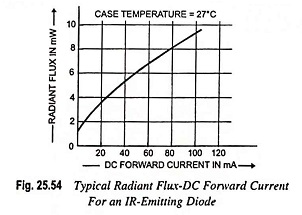IR Emitters or Infrared-emitting diodes:
IR Emitters or Infrared-emitting diodes are solid-state gallium arsenide devices that emit a beam of radiant flux when forward biased. Fig. 25.53 depicts the basic construction of the device. When the junction is forward biased, electrons from the N-region will recombine with excess holes of the P-material in a specially designed recombination region sandwiched between the P- and N-type materials.
During this combination, energy is radiated away from the device in the form of photons. The generated photons either will be reabsorbed in the structure or leave the surface of the device as radiant energy, as depicted in Fig. 25.53. The radiant energy from the device is infrared with a typical peak of 0.9 μm, which ideally matches the response of silicon photodiode and phototransistors. Fig. 25.54 indicates that the relationship between the radiant flux and dc forward current is almost linear.
Applications:
A few areas of applications for such devices are card and paper-tape readers, shaft encoders, data-transmission systems, intrusion alarms and high density mounting applications. The shaft encoder can produce 150 μW of radiant energy at 1.2 V and 50 mA.
